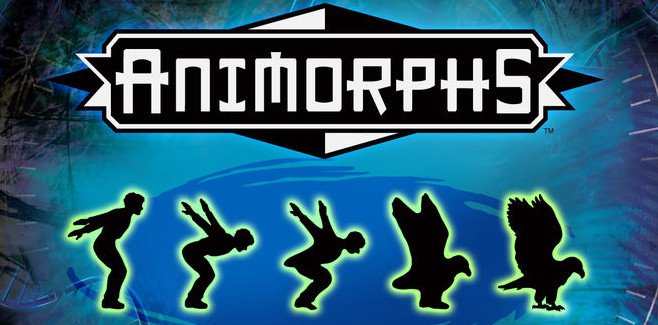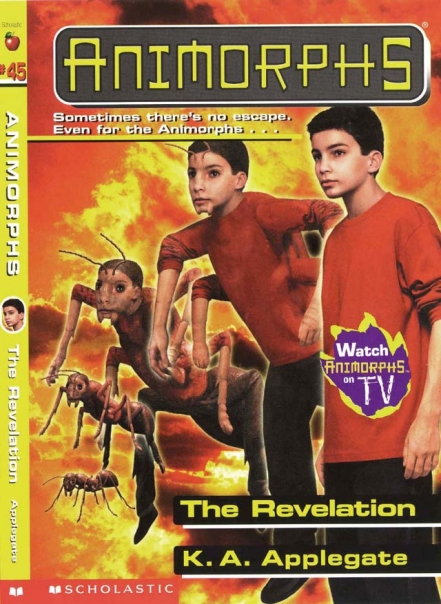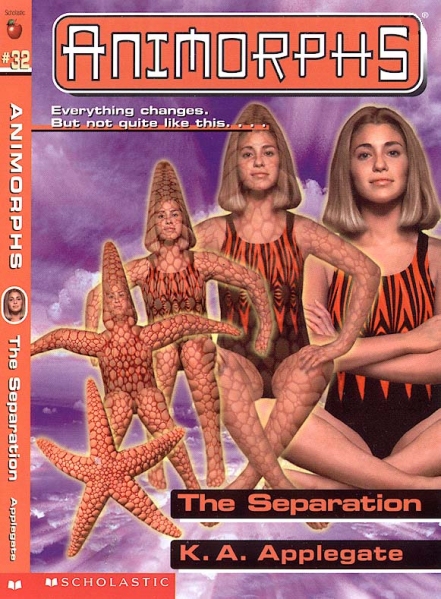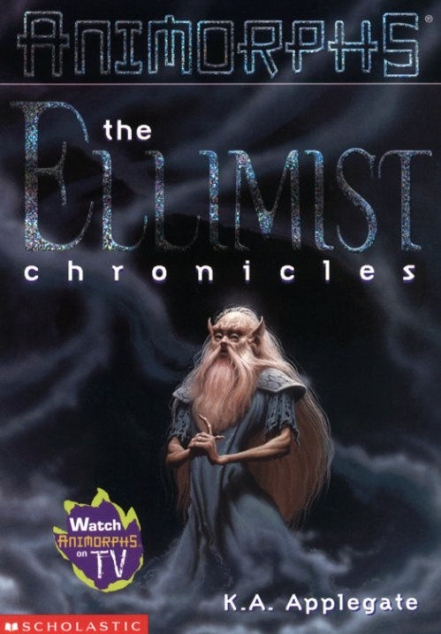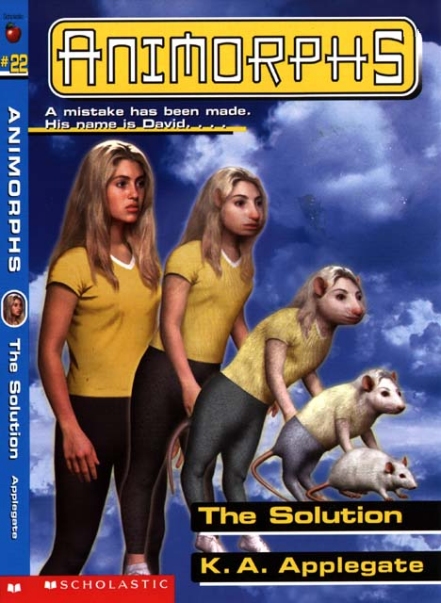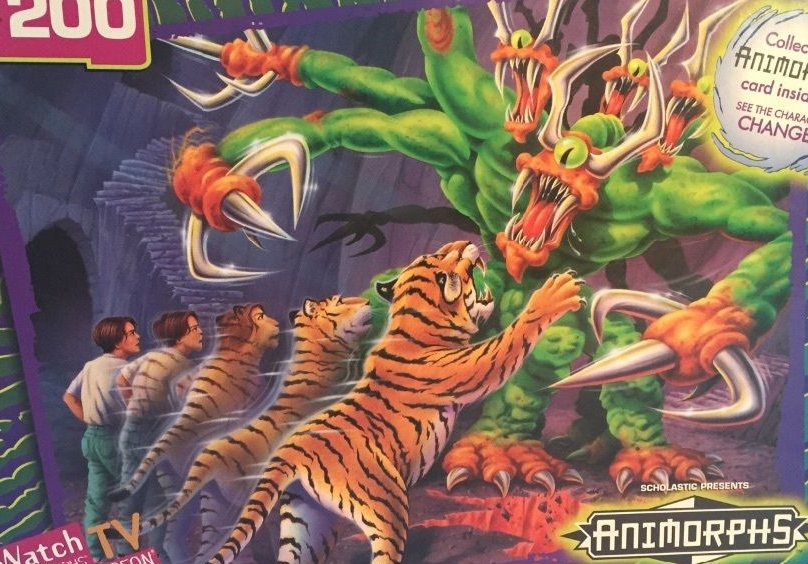It is currently nearing the end of June, and you know what that means: we're one month away from August 1st, A.K.A. Halloween. I was actually sure that this year I might get out some more articles that were neither Halloween nor the new daily pokemon reviews, but time slipped me by, and if we're gearing up for Halloween anyway, we may as well talk about one of the most visceral works of horror ever penned by human hands...or was it?
Yes, we're going to talk about K.A. Applegates Animorphs, and if you only know this series from its name and cover art, you're probably in for an even weirder treat. You probably think it's all fun and games for children to turn into elephants and kangaroos. It's a children's series, after all, with a premise that sounds like a recipe for pure hijinks, and of course it is, if your definition of "hijinks" extends to things like, say, desperately trying to keep your own intestines from spilling out as you grapple a blade-encrusted space lizard, or weighing whether or not you should kill your entire family to spare them a living hell as a prisoner of their own body, or how about the family favorite we call uncontrollable autocannibalism?
This children's series called Animorphs pulls absolutely no punches. What you sign up for is a little boy becoming a gorilla. What you get is an existential war epic that lays bare all the terrible wonder of life's indiscriminate cruelty.
So, let's start with a recap of what this series is about. You've got five kids - Jake, Marco, Tobias, Rachel and Cassie - who get embroiled in an intergalactic war between the four-eyed, mouthless, centaur-like Andalites and the body-stealing, parasitic, sluglike Yeerks, who have chosen Earth as the springboard for galactic conquest. Later, the kids are joined by a naive young Andalite cadet, Ax, who lives in the woods with a bird and a TV and collects magazine photos of cinnamon buns, but we're getting ahead of ourselves.
The power to "morph" is the most coveted technology and greatest weapon of the Andalites, and it allows you to permanently add the DNA of any other animal species to your own. At any time, you can transform completely into any form you've ever acquired this way, you conveniently have access to telepathic communication while morphed, and any injuries you may sustain in one form are erased when you switch to another.
The downsides are that you have to de-morph back to your original state before morphing again, so you can't just go from human to mudskipper to xebu, and if you're morphed for more than exactly two hours, you'll be trapped in that form permanently, which actually happens in the very first book to Tobias, who becomes a red-tailed hawk and a total weirdo who lives out in the woods with an alien and a TV, but we're getting ahead of ourselves again.
With all this in mind, it's time to discuss...
The Thirteen Ghastliest Horrors of Animorphs
#13: The Physics of Morphing
Morphing technology is not the kind of transformation that gets bathed in sparkly lights and colorful smoke. Almost every time the kids swap species, we're treated to descriptions that would make Shintaro Kago itchy. Want to change into a bat? Fly around with awesome sonar powers? Better be prepared for your bones to burst like party streamers from your fingertips before the rest of your skin catches up. Speaking of bones, you can enjoy the sensation of them liquefying as you morph into any invertebrate. Eyeballs boil and blister into the thousand lenses of a fly, skin cracks and peels into the feathers of a goose, faces pop open into writhing tubes before knitting back into the visage of a lobster. None of it hurts, but it's all the kids can do to keep their sanity as they feel themselves mangled inside-out in a thousand new ways over the course of their adventures, to say nothing of those poor civilian suckers who barge in on them mid-morph from time to time.#12: The Psychology of Morphing
Naturally, waking up in a completely foreign body can really do a number on the human consciousness, especially since, in a sense, you're not alone in there. When you morph into a chicken, you're simultaneously yourself and the chicken, like two pilots flying the same plane. It's useful to have a subconscious that knows exactly what to do with your newfound wings, hooves or tentacles, but it can also pose some difficulties, especially when the animal's instincts overpower your own.This takes an especially dark turn when our heroes morph into ants for the first time. The ant's sense of simple purpose in a greater, highly ordered colony is so absolute that the kids almost immediately lose their sense of individuality and get lost in the life of an ant. Their little ant bodies go about their usual little ant business oblivious to the human beings trapped within, sinking into a dreamlike haze even while a part of them screams and sobs and metaphysically claws at the edge of its own humanity.
And speaking of screaming, there's an ant that accidentally ends up morphing into a human in a later book, and when something with only the experiences of an ant finds itself with a relatively vast new sense of being in an incomprehensible new environment, screaming is all it can do.
#11: The Downside to Regeneration
It sounds great, on paper, to be able to erase any injury you could ever conceivably sustain if you can just cling to consciousness long enough to switch forms, but shit still hurts, and a lot of shit happens to these kids. I've mentioned their guts spilling out. That's happened more than once. It's happened more than once to the same kid. They've been dismembered, crushed, burned, bitten in half by a shark and had their flesh eaten by - what else? - ants.Perhaps nothing beats the time when Rachel, shrunk by alien technology, morphed into a tiny elephant inside her friend's stomach. It sounds laughable, sure, but she enjoyed the lovely experience of her eyeballs completely digested by her own friend's gastric acids before she could change back.
In another book, the same character gets chopped completely in half while in the form of a starfish, and each half of the echinoderm morphs back into a complete clone of Rachel... except that one is a remorseless sadist.
#10: The Fake McDonald's
It's a long, long story, but this will be the shortest and most specific entry here: in one of the Chronicles books, alien forces recreate a crude imitation of the planet Earth that seems perfectly real, right down to a Mcdonald's the book's heroine always visited. It even remembered the boy there who always tried to flirt with her, and the fact that, much to her embarrassment, his acne turned her off. The clumsy, muffled thing that attempts to serve her food looks almost human, except for the exaggerated mess of putrid zits it has in place of any eyes, nose or mouth opening.#9: Life with a Yeerk
The idea of losing control of your own body is nothing new to science fiction, but Animorphs takes special care to drive home what it's really like to be nothing but a backseat passenger in your own head. The host of a Yeerk remains completely conscious and can feel everything that happens to their body, just as always, except their body is doing and saying only what the alien slug wants, watching helplessly as it takes over their old life, lies to their friends and assimilates their loved ones.The only relief a host gets - unless they've got themselves a compassionate Yeerk or even enjoy the whole "freeloading in your own brain" thing, both of which actually happen quite a bit - is when the parasite must leave its host once every three days to feed on their only source of sustenance, Kandrona rays, as they swim in a special pool back at home base. Unwilling hosts spend their few short hours of cerebral freedom corralled like animals in tight cages, many of them having been through the routine long enough that they just sit down and wait compliantly for reinfestation.
This reaches a crescendo of horror when we visit a hypothetical future in which the Yeerks have successfully conquered the planet. Every single human being is born directly into slavery as a Yeerk host, sleeps in a closet-sized prison, and is randomly selected every so often to breed with another randomly selected host, both under Yeerk control through the entire process.
Only in the rip-roarin', knee-slappin' good-time adventures of the Animorphs!
#8: Life AS a Yeerk
Imagine being completely blind, tiny and helpless your entire life, a limbless slug swimming in a viscous sludge and communicating with your fellow slugs through tiny, adorable squeaks. You've heard about what it's like to have a real body, but you can't even imagine what words like "color" and "taste" mean, until you're finally provided a host. Now you can walk and talk and hold things and listen to music and experience an unimaginable universe of infinite wonder, every moment of it pure, rapturous joy.Except, of course, that there's another being in your head, the rightful owner of your new body, screaming in terror, rage, disgust and hate towards your existence. You might feel bad about it, but the only prospects more hellish are either returning to the life of a blind slug or whatever punishments may be in store for you should you refuse to comply with the invasion.
The most disturbing thing about the Yeerks isn't that they're parasites, but that they're people, and they truly just want the freedom so many other people have. They just don't have a means of obtaining that freedom without taking it away from something else.
.......At least, not so long as Andalites fearfully keep the power of morphing to themselves, paranoid that it will be used only to exterminate them.
#7 Erek's "off screen" Rampage
Andalites and Yeerks aren't the only aliens living secretively on Earth; eventually, the Andalites encounter the Chee, android beings resembling humanoid dogs with a weird, complicated backstory we're not going to get into, suffice to say that Chee are devastatingly powerful and monstrously intelligent, but are sickened by any form of violence and programmed to remain pacifistic at all costs.Realizing that it's kind of messed up to just sit around and silently watch while weaker beings are invaded and enslaved, a Chee named Erek successfully reprograms himself and removes his inhibitions against combat.
This series never usually shies away from describing violence in graphic, gory detail...until Erek is set loose on several dozen enemy Yeerk hosts, which as you recall, are innocent people puppeted around against their will. There are no survivors, the kids who witness the events never speak of what they saw, and neither does Erek, undoing the changes he made to his programming and destroying the device that permitted them at all, even knowing that in doing so he is only extending the war and dooming innumerable more lives.
It's an ugly moral dilemma with no easy answers. It shouldn't be right to force someone to kill, but what if that's the only way to save far more lives in the long run? Some of the kids support Erek's final decision, some never really forgive him, and both are kind of simultaneously right. The psychological and existential costs of war are a running theme throughout these books, and they always come back to a central idea that war has no simple "good guys."
#6: The Truth About Howlers
In Animorphs #26, The Attack, the team is up against creatures known as Howlers, carefully engineered by a cosmic horror called Crayak as his ultimate killing machines. The rocky, jointed humanoids (with big, beautiful blue eyes) have remorselessly slaughtered countless species on countless worlds - including the original creators of the cybernetic Chee - and their shared mental network has no memory of a single Howler ever losing a single battle.The Howlers seem like your average mindless, murderous super-soldiers and hopeless to defeat, until the Animorphs are given a glimpse into the Howler's minds. What they find there is neither a cold, calculating killing machine or anything resembling malice, but innocent, child-like joy. They never develop past three years of age before Crayak terminates them, and they're completely unaware that other creatures have feelings or that violence has permanent consequences. They're an entire species trapped in what's actually toddlerhood, and they believe everything they're doing is just a harmless game.
It's all par for the course where Crayak is concerned. The "big bad" of Animorphs is a god-like entity driven by disturbingly human-like cruelty, ego and good old boredom to orchestrate war, chaos and destruction across our universe. He's a big, spoiled kid shaking up a jar of hornets just to see what happens, and a stark contrast to his own Howlers: they commit atrocities because it's fun and they don't know better. Crayak does it because it's fun and he DOES know better.
#5: Life as a Taxxon
Humans, of course, aren't the only things Yeerks employ as minions and vessels. They've also got these bladed, reptilian bird-things called the Hork-Bajir and giant, slobbering, centipede-like monstrosities called Taxxons in their employ, and while it's not long before we get to know the Hork-Bajir more intimately and sympathetically, most of their appearances hammer home an idea that Taxxons are little more than savage, single-minded eating machines so ravenous, so unfeeling that they'll immediately devour one another or even their own back ends as soon as they smell blood.So, maybe you're noticing a pattern by now. When the kids finally morph into Taxxons, they find themselves panic-stricken with a torturous, clawing hunger, an overwhelming terror of getting any hungrier and a bonus sense of intense claustrophobia. Together, these instincts make the Taxxons highly efficient, relentless tunnelers, eating mouthful after mouthful of soil and rock just to stave off the panic, though they're still doomed to starve if they don't get any meat.
Later, in one of the Chronicles books, we're finally given a look at the Taxxon homeworld, and an enormous "living hive" in which the creatures are born, protected and provided a relatively constant supply of food. The hive is even fully conscious, and expresses fury that so many of its children have been taken by the Yeerks.
Even their life in the hive is described as fairly brutal, but it's obvious that the terrifying, uncontrollable ravenousness of the Taxxons is far from helped by separation from their natural environment, ideal food source and caring mother. Their obedience to the Yeerks (who seldom look forward to actually controlling a Taxxon) and destructive power are all just a side effect of a life in perpetual starvation.
#4: The Real Atlantis
Wow, Atlantis! That's fun, right!? Every sci-fi-fantasy broad enough in scope gives us an underwater civilization sooner or later, usually populated by enlightened, peaceful mer-people who ride giant seahorses and hide their advanced technology from those evil surface-walkers.So, naturally, the Animorphs version gives us a slowly dying race of inbred, mutant fish people whose technology is simply scavenged and repurposed from us landlubbers, their magnificent city cobbled together from salvaged trash and scrap metal.
They're fortunately fairly hospitable to human visitors, at least until they've learned everything they need from them, at which point they paralyze them, dissect them alive for research, extract DNA for their reproductive experiments, and stuff the remaining corpses for educational exhibition.
#3: The Quantum Virus
Few things in Animorphs are quite as sad as the amount of faith the kids initially put in the Andalites. All they know of these pretty, blue space elves comes from their good friend Ax, who is certain his virtuous, glorious empire will arrive on Earth any minute now and heroically rescue the human race from the despicable Yeerks. They're the good species, right? They've been fighting those gross, awful slugs for generations out of passionate concern for the freedom and safety of all other species...right?In the companion book The Hork-Bajir Chronicles, we learn the backstory of the Yeerk's lizard-like alien slaves. They're big, frightening and deadly under Yeerk control, but the saurians themselves are actually peace-loving herbivores who barely grasp the idea of fighting back when the Yeerks begin invading their world and enslaving their people.
Terrified of facing an army of these powerful creatures, the Andalites hatch a plan to stop the Yeerks once and for all: an artificial "space-time disease," a "quantum virus" that will target the entire Hork-Bajir species and agonizingly disassemble them at the molecular level. It doesn't work out, but the very existence of the virus and of the proposed genocide is horrific enough to be officially denied by the Andalite empire, chalked up to nothing but a hateful Yeerk smear campaign.
The Andalites are the saviors of many planets and certainly have compassion for other life forms, but at the end of the day, their motivation is nothing more than the survival of their own species and victory over the Yeerks, at absolutely any cost.
#2: Father
In The Ellimist Chronicles, we're given our most formal introduction to the maniacal Crayak and his eternal nemesis, the (relatively) benevolent or at least good-intentioned Ellimist, who was once a humble, mortal bird-like alien named Toomin. It's a long story, obviously - it does fill its own entire book - but his transformation into cosmic demigod begins when he meets an entity that only calls itself "Father.""Father" is a sponge-like aquatic organism of titanic proportions, its tentacles spanning an entire water-covered moon devoid of any other life. Father is capable fusing these tentacles with the bodies of his prey, absorbing their minds into his own and amassing an enormous collection of alien bodies that never decompose in the icy, underwater abyss.
Out of loneliness and curiosity, Toomin becomes the first and only being ever kept alive by this monster, forced for centuries to play various games against it in a lifelike dreamscape. Between these rigged, unfair play dates, Toomin can do nothing but wait and hope for an escape, imprisoned on the end of one vast tentacle in an endless garden of silent, swaying corpses.
#1: David
Survival can lead people to do some pretty unpleasant things. That's pretty much the entire crux of Animorphs, if you hadn't noticed already, and while memorable examples come and go throughout the series, it's the saga of David, the "sixth Animorph," that might really stick with you.David is a kid who goes to the same high school as our heroes, and he's not a particularly pleasant kid to get along with, but he ends up finding the Andalite "morphing cube" that actually carries the morphing power, becomes an inevitable target of the Yeerks and inadvertantly forces the Animorphs to get involved in his life.
Attempts to steal back the cube promptly result in David's parents getting infested, his house half-destroyed, and a search put out for David himself. The kids feel a responsibility to recruit and train David as one an Animorph like themselves, but like we said, he doesn't entirely play well with others. He botches missions, he questions authority, he takes violence too far and he even creeps on girls. A degree of unpleasantness is to be expected when you're sucked into an interplanetary war by the same kids who just destroyed your entire life, but things escalate between David and the other kids until he threatens to expose them to the Yeerks and even attempts to kill one of them.
The kids aren't really left with many options. Once David makes himself a threat to their loved ones, a threat to their mission and by extension a threat to the entire world at large, it's them or him.
Through an insidiously clever plan, David is tricked into the form of a rat and trapped underground where he can't possibly de-morph without dying. He begs and pleads and bargains for his humanity, but the kids can't risk it with what he knows. They trap their fellow human child in the body of a rat for the rest of his life, which they are well aware will only be another year or two at best...and they leave him on a tiny, isolated island, little more than a very big rock, with only other rats for company and washed-up trash to eat.
Thus concludes the original "David Trilogy," Animorphs #20 to #21, but it's not his final appearance. That would be Animorphs #48, The Return, and there's really nothing I'm willing to spoil this time, except to say, JESUS.
When I decided I'd be writing this, I figured I'd have a brief list of unusually dark moments that maybe a handful of people would find interesting. Instead, there was a massive turnout of excitement when I just mentioned I was going to write about the Animorphs, and every entry here kind of got away from me and ballooned into something bigger. Even so, we've barely scratched the surface of the series shocking twists and turns, attention to detail and seemingly boundless imagination.
For every spoiler I've dropped here, there are still several greater surprises waiting if you've still never read this series, and you're definitely never too old to begin. Take it from me; I was an animal-obsessed, monster-obsessed thirteen-year-old when the series debuted, its most ideal possible target, but I guess I was just too busy buying Magic: The Gathering cards or watching Digimon Adventure at the time and allowed the whole Animorphs phenomenon to slip me by completely.
I wouldn't experience this series until I was thirty years old and my spouse began reading the books to me out loud during long drives, reaching the final book in the summer of 2015, as we drove away from Florida once and for all. I'm actually really glad I held off on Animorphs for somebody special, and through the lens of what is technically, I guess, supposed to be an adult by now, I'm pretty sure I appreciated these books on levels I never could have at only thirteen...especially since the scariest kid's novel I'd ever read at the time was Goosebumps: The Haunted Mask.
Whether you're a new or old reader, you can get book-by-book recaps, reviews and snarky commentary from Cinnamon Bunzuh on blogspot, which is also where I yanked most of the cover scans while double-checking some of my facts.
Finally, if you're intrigued by some of the freaky aliens we've talked about here, you've pretty much seen nothing yet. Stay tuned for an even more site-appropriate article on the xenobiology of Animorphs.

